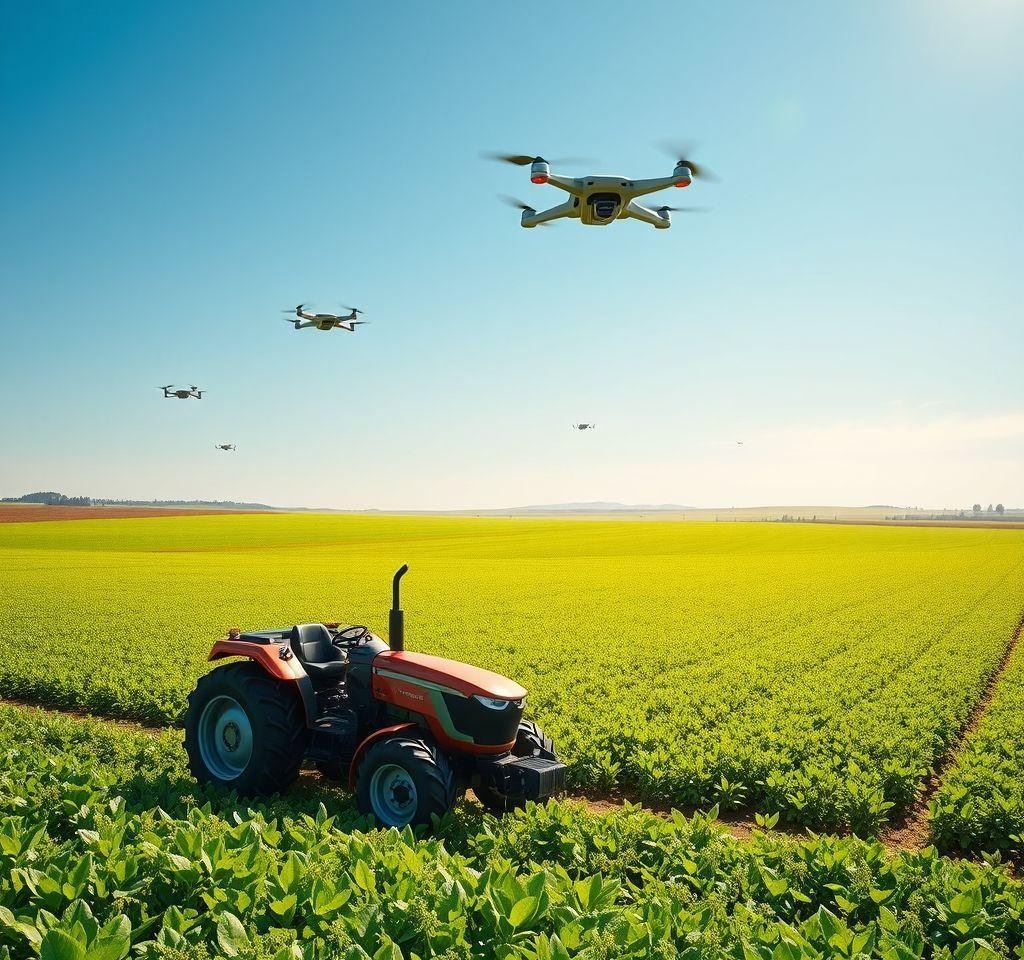AI in Journalism: Revolutionizing News Production and Fact-Checking
AI is redefining journalism’s core functions, from content creation to verification. This article examines how automation drives efficiency while addressing ethical imperatives for accuracy and accountability.
The Rise of AI in Modern Journalism
The Rise of AI in Modern Journalism
Automated reporting is transforming journalism. Tools leveraging natural language processing (NLP) and machine learning are automating routine tasks. This boosts efficiency and lowers costs.
NLP enables systems to understand and generate human language. This automates tasks like writing simple news reports. These systems can quickly analyze data and produce reports on things like sports scores or financial data.
Machine learning algorithms improve over time. They learn to write more effectively. This leads to better quality automated content. Some systems can even produce more complex reports. This frees human journalists to focus on investigative work and analysis.
The adoption of these tools signifies a major shift. It changes the way news is produced and consumed. News organizations benefit from increased speed and reduced expenditure. The focus shifts to in-depth reporting and analysis. This results in higher-quality content, despite cost reductions.
Automated Content Generation
The Rise of AI in Modern Journalism
Automated reporting is transforming journalism. Tools leveraging natural language processing (NLP) and machine learning are automating routine tasks. This boosts efficiency and lowers costs.
NLP enables systems to understand and generate human language. This automates tasks like writing simple news reports. These systems can quickly analyze data and produce reports on things like sports scores or financial data.
Machine learning algorithms improve over time. They learn to write more effectively. This leads to better quality automated content. Some systems can even produce more complex reports. This frees human journalists to focus on investigative work and analysis.
The adoption of these tools signifies a major shift. It changes the way news is produced and consumed. News organizations benefit from increased speed and reduced expenditure. The focus shifts to in-depth reporting and analysis. This results in higher-quality content, despite cost reductions.
Fact-Checking at Machine Speed
The Rise of AI in Modern Journalism
Automated reporting is transforming journalism. Tools leveraging natural language processing (NLP) and machine learning are automating routine tasks. This boosts efficiency and lowers costs.
NLP enables systems to understand and generate human language. This automates tasks like writing simple news reports. These systems can quickly analyze data and produce reports on things like sports scores or financial data.
Machine learning algorithms improve over time. They learn to write more effectively. This leads to better quality automated content. Some systems can even produce more complex reports. This frees human journalists to focus on investigative work and analysis.
The adoption of these tools signifies a major shift. It changes the way news is produced and consumed. News organizations benefit from increased speed and reduced expenditure. The focus shifts to in-depth reporting and analysis. This results in higher-quality content, despite cost reductions.
Ethical Dilemmas and Human-AI Collaboration
The Rise of AI in Modern Journalism
Automated reporting is transforming journalism. Tools leveraging natural language processing (NLP) and machine learning are automating routine tasks. This boosts efficiency and lowers costs.
NLP enables systems to understand and generate human language. This automates tasks like writing simple news reports. These systems can quickly analyze data and produce reports on things like sports scores or financial data.
Machine learning algorithms improve over time. They learn to write more effectively. This leads to better quality automated content. Some systems can even produce more complex reports. This frees human journalists to focus on investigative work and analysis.
The adoption of these tools signifies a major shift. It changes the way news is produced and consumed. News organizations benefit from increased speed and reduced expenditure. The focus shifts to in-depth reporting and analysis. This results in higher-quality content, despite cost reductions.
Future Frontiers: Generative AI and Deepfakes
The Rise of AI in Modern Journalism
Automated reporting is transforming journalism. Tools leveraging natural language processing (NLP) and machine learning are automating routine tasks. This boosts efficiency and lowers costs.
NLP enables systems to understand and generate human language. This automates tasks like writing simple news reports. These systems can quickly analyze data and produce reports on things like sports scores or financial data.
Machine learning algorithms improve over time. They learn to write more effectively. This leads to better quality automated content. Some systems can even produce more complex reports. This frees human journalists to focus on investigative work and analysis.
The adoption of these tools signifies a major shift. It changes the way news is produced and consumed. News organizations benefit from increased speed and reduced expenditure. The focus shifts to in-depth reporting and analysis. This results in higher-quality content, despite cost reductions.
The Rise of AI in Modern Journalism
Automated Content Generation
AI-driven platforms are generating news articles, financial reports, and sports summaries. These systems offer significant scalability and real-time updates. This technology streamlines news production, improving speed and efficiency.
These platforms utilize natural language processing (NLP) and machine learning (ML). NLP helps the systems understand and generate human-like text. ML allows for continuous improvement and refinement of writing style. The systems analyze data, identify key points, and automatically create content.
The result is rapid dissemination of information. Breaking news, financial updates, and sports summaries are available much faster. This improves timeliness and provides instant coverage of major events. Human journalists can focus on more complex tasks, enhancing overall news quality. This technological advancement enhances the reach and efficiency of news operations. It also reduces production time and costs.
Automated Content Generation
Automated Content Generation
AI-driven platforms are generating news articles, financial reports, and sports summaries. These systems offer significant scalability and real-time updates. This technology streamlines news production, improving speed and efficiency.
These platforms utilize natural language processing (NLP) and machine learning (ML). NLP helps the systems understand and generate human-like text. ML allows for continuous improvement and refinement of writing style. The systems analyze data, identify key points, and automatically create content.
The result is rapid dissemination of information. Breaking news, financial updates, and sports summaries are available much faster. This improves timeliness and provides instant coverage of major events. Human journalists can focus on more complex tasks, enhancing overall news quality. This technological advancement enhances the reach and efficiency of news operations. It also reduces production time and costs.
Fact-Checking at Machine Speed
Automated Content Generation
AI-driven platforms are generating news articles, financial reports, and sports summaries. These systems offer significant scalability and real-time updates. This technology streamlines news production, improving speed and efficiency.
These platforms utilize natural language processing (NLP) and machine learning (ML). NLP helps the systems understand and generate human-like text. ML allows for continuous improvement and refinement of writing style. The systems analyze data, identify key points, and automatically create content.
The result is rapid dissemination of information. Breaking news, financial updates, and sports summaries are available much faster. This improves timeliness and provides instant coverage of major events. Human journalists can focus on more complex tasks, enhancing overall news quality. This technological advancement enhances the reach and efficiency of news operations. It also reduces production time and costs.
Ethical Dilemmas and Human-AI Collaboration
Automated Content Generation
AI-driven platforms are generating news articles, financial reports, and sports summaries. These systems offer significant scalability and real-time updates. This technology streamlines news production, improving speed and efficiency.
These platforms utilize natural language processing (NLP) and machine learning (ML). NLP helps the systems understand and generate human-like text. ML allows for continuous improvement and refinement of writing style. The systems analyze data, identify key points, and automatically create content.
The result is rapid dissemination of information. Breaking news, financial updates, and sports summaries are available much faster. This improves timeliness and provides instant coverage of major events. Human journalists can focus on more complex tasks, enhancing overall news quality. This technological advancement enhances the reach and efficiency of news operations. It also reduces production time and costs.
Future Frontiers: Generative AI and Deepfakes
Automated Content Generation
AI-driven platforms are generating news articles, financial reports, and sports summaries. These systems offer significant scalability and real-time updates. This technology streamlines news production, improving speed and efficiency.
These platforms utilize natural language processing (NLP) and machine learning (ML). NLP helps the systems understand and generate human-like text. ML allows for continuous improvement and refinement of writing style. The systems analyze data, identify key points, and automatically create content.
The result is rapid dissemination of information. Breaking news, financial updates, and sports summaries are available much faster. This improves timeliness and provides instant coverage of major events. Human journalists can focus on more complex tasks, enhancing overall news quality. This technological advancement enhances the reach and efficiency of news operations. It also reduces production time and costs.
The Rise of AI in Modern Journalism
Fact-Checking at Machine Speed
AI systems are revolutionizing fact-checking. They offer speed and efficiency previously unimaginable. These systems analyze information, identify discrepancies, and verify claims in real time. This helps combat misinformation and enhances journalistic integrity.
These tools use advanced algorithms. They cross-reference information from multiple sources. They identify inconsistencies and potential inaccuracies. This allows for rapid verification or debunking of claims. Integration into editorial workflows streamlines the process.
The improvement in accuracy is substantial. Automated fact-checking reduces human error. It significantly speeds up the process. This allows news organizations to address misinformation quickly and effectively. The result is more reliable and trustworthy news.
Furthermore, these systems help journalists. They assist with identifying false claims. They help in verifying the accuracy of statements. This leads to more responsible and ethical journalism. The integration of fact-checking technology is changing the industry. It enhances both efficiency and trustworthiness of reporting.
Automated Content Generation
Fact-Checking at Machine Speed
AI systems are revolutionizing fact-checking. They offer speed and efficiency previously unimaginable. These systems analyze information, identify discrepancies, and verify claims in real time. This helps combat misinformation and enhances journalistic integrity.
These tools use advanced algorithms. They cross-reference information from multiple sources. They identify inconsistencies and potential inaccuracies. This allows for rapid verification or debunking of claims. Integration into editorial workflows streamlines the process.
The improvement in accuracy is substantial. Automated fact-checking reduces human error. It significantly speeds up the process. This allows news organizations to address misinformation quickly and effectively. The result is more reliable and trustworthy news.
Furthermore, these systems help journalists. They assist with identifying false claims. They help in verifying the accuracy of statements. This leads to more responsible and ethical journalism. The integration of fact-checking technology is changing the industry. It enhances both efficiency and trustworthiness of reporting.
Fact-Checking at Machine Speed
Fact-Checking at Machine Speed
AI systems are revolutionizing fact-checking. They offer speed and efficiency previously unimaginable. These systems analyze information, identify discrepancies, and verify claims in real time. This helps combat misinformation and enhances journalistic integrity.
These tools use advanced algorithms. They cross-reference information from multiple sources. They identify inconsistencies and potential inaccuracies. This allows for rapid verification or debunking of claims. Integration into editorial workflows streamlines the process.
The improvement in accuracy is substantial. Automated fact-checking reduces human error. It significantly speeds up the process. This allows news organizations to address misinformation quickly and effectively. The result is more reliable and trustworthy news.
Furthermore, these systems help journalists. They assist with identifying false claims. They help in verifying the accuracy of statements. This leads to more responsible and ethical journalism. The integration of fact-checking technology is changing the industry. It enhances both efficiency and trustworthiness of reporting.
Ethical Dilemmas and Human-AI Collaboration
Fact-Checking at Machine Speed
AI systems are revolutionizing fact-checking. They offer speed and efficiency previously unimaginable. These systems analyze information, identify discrepancies, and verify claims in real time. This helps combat misinformation and enhances journalistic integrity.
These tools use advanced algorithms. They cross-reference information from multiple sources. They identify inconsistencies and potential inaccuracies. This allows for rapid verification or debunking of claims. Integration into editorial workflows streamlines the process.
The improvement in accuracy is substantial. Automated fact-checking reduces human error. It significantly speeds up the process. This allows news organizations to address misinformation quickly and effectively. The result is more reliable and trustworthy news.
Furthermore, these systems help journalists. They assist with identifying false claims. They help in verifying the accuracy of statements. This leads to more responsible and ethical journalism. The integration of fact-checking technology is changing the industry. It enhances both efficiency and trustworthiness of reporting.
Future Frontiers: Generative AI and Deepfakes
Fact-Checking at Machine Speed
AI systems are revolutionizing fact-checking. They offer speed and efficiency previously unimaginable. These systems analyze information, identify discrepancies, and verify claims in real time. This helps combat misinformation and enhances journalistic integrity.
These tools use advanced algorithms. They cross-reference information from multiple sources. They identify inconsistencies and potential inaccuracies. This allows for rapid verification or debunking of claims. Integration into editorial workflows streamlines the process.
The improvement in accuracy is substantial. Automated fact-checking reduces human error. It significantly speeds up the process. This allows news organizations to address misinformation quickly and effectively. The result is more reliable and trustworthy news.
Furthermore, these systems help journalists. They assist with identifying false claims. They help in verifying the accuracy of statements. This leads to more responsible and ethical journalism. The integration of fact-checking technology is changing the industry. It enhances both efficiency and trustworthiness of reporting.
The Rise of AI in Modern Journalism
Ethical Dilemmas and Human-AI Collaboration
AI in journalism presents ethical challenges. Bias in training data is a significant concern. AI systems can perpetuate and amplify existing societal biases. This can lead to unfair or inaccurate reporting. Careful curation of training data is crucial to mitigate these risks.
Concerns about job displacement are also prevalent. Automation may lead to a reduction in certain journalism roles. However, it also creates new opportunities. New roles focused on AI oversight and analysis may emerge.
Human oversight is essential. It ensures accuracy and ethical considerations. A hybrid workflow is optimal. This involves journalists supervising AI-generated outputs. This approach combines efficiency gains with human judgment and ethical responsibility. Journalists need to verify information. They need to maintain context and editorial control.
Therefore, a collaborative approach is necessary. This combines the speed and efficiency of AI with human expertise. This balances technological progress with the ethical obligations of journalism. This ensures accurate, fair, and responsible news reporting.
Automated Content Generation
Ethical Dilemmas and Human-AI Collaboration
AI in journalism presents ethical challenges. Bias in training data is a significant concern. AI systems can perpetuate and amplify existing societal biases. This can lead to unfair or inaccurate reporting. Careful curation of training data is crucial to mitigate these risks.
Concerns about job displacement are also prevalent. Automation may lead to a reduction in certain journalism roles. However, it also creates new opportunities. New roles focused on AI oversight and analysis may emerge.
Human oversight is essential. It ensures accuracy and ethical considerations. A hybrid workflow is optimal. This involves journalists supervising AI-generated outputs. This approach combines efficiency gains with human judgment and ethical responsibility. Journalists need to verify information. They need to maintain context and editorial control.
Therefore, a collaborative approach is necessary. This combines the speed and efficiency of AI with human expertise. This balances technological progress with the ethical obligations of journalism. This ensures accurate, fair, and responsible news reporting.
Fact-Checking at Machine Speed
Ethical Dilemmas and Human-AI Collaboration
AI in journalism presents ethical challenges. Bias in training data is a significant concern. AI systems can perpetuate and amplify existing societal biases. This can lead to unfair or inaccurate reporting. Careful curation of training data is crucial to mitigate these risks.
Concerns about job displacement are also prevalent. Automation may lead to a reduction in certain journalism roles. However, it also creates new opportunities. New roles focused on AI oversight and analysis may emerge.
Human oversight is essential. It ensures accuracy and ethical considerations. A hybrid workflow is optimal. This involves journalists supervising AI-generated outputs. This approach combines efficiency gains with human judgment and ethical responsibility. Journalists need to verify information. They need to maintain context and editorial control.
Therefore, a collaborative approach is necessary. This combines the speed and efficiency of AI with human expertise. This balances technological progress with the ethical obligations of journalism. This ensures accurate, fair, and responsible news reporting.
Ethical Dilemmas and Human-AI Collaboration
Ethical Dilemmas and Human-AI Collaboration
AI in journalism presents ethical challenges. Bias in training data is a significant concern. AI systems can perpetuate and amplify existing societal biases. This can lead to unfair or inaccurate reporting. Careful curation of training data is crucial to mitigate these risks.
Concerns about job displacement are also prevalent. Automation may lead to a reduction in certain journalism roles. However, it also creates new opportunities. New roles focused on AI oversight and analysis may emerge.
Human oversight is essential. It ensures accuracy and ethical considerations. A hybrid workflow is optimal. This involves journalists supervising AI-generated outputs. This approach combines efficiency gains with human judgment and ethical responsibility. Journalists need to verify information. They need to maintain context and editorial control.
Therefore, a collaborative approach is necessary. This combines the speed and efficiency of AI with human expertise. This balances technological progress with the ethical obligations of journalism. This ensures accurate, fair, and responsible news reporting.
Future Frontiers: Generative AI and Deepfakes
Ethical Dilemmas and Human-AI Collaboration
AI in journalism presents ethical challenges. Bias in training data is a significant concern. AI systems can perpetuate and amplify existing societal biases. This can lead to unfair or inaccurate reporting. Careful curation of training data is crucial to mitigate these risks.
Concerns about job displacement are also prevalent. Automation may lead to a reduction in certain journalism roles. However, it also creates new opportunities. New roles focused on AI oversight and analysis may emerge.
Human oversight is essential. It ensures accuracy and ethical considerations. A hybrid workflow is optimal. This involves journalists supervising AI-generated outputs. This approach combines efficiency gains with human judgment and ethical responsibility. Journalists need to verify information. They need to maintain context and editorial control.
Therefore, a collaborative approach is necessary. This combines the speed and efficiency of AI with human expertise. This balances technological progress with the ethical obligations of journalism. This ensures accurate, fair, and responsible news reporting.
The Rise of AI in Modern Journalism
Future Frontiers: Generative AI and Deepfakes
Generative AI and AI-driven media detection are reshaping journalism. Advanced systems offer new investigative possibilities. They also present challenges related to misinformation. The creation and detection of synthetic media, or deepfakes, require careful consideration.
Generative AI tools can assist with investigative work. They can analyze large datasets to uncover hidden connections. They can also generate summaries of complex information. This accelerates the investigative process. It allows for faster exploration of leads.
However, the rise of deepfakes presents significant risks. These realistic but fabricated videos and audios can be used to spread misinformation. AI-powered tools are crucial for detecting these deepfakes. Early detection is vital for maintaining journalistic integrity.
Robust regulatory frameworks and industry standards are needed. These are necessary to address the ethical and practical challenges posed by these technologies. Clear guidelines are required for responsible use of AI in journalism. This ensures the accuracy and trustworthiness of news reporting. Transparency is key in disclosing the use of AI tools in news production.
Automated Content Generation
Future Frontiers: Generative AI and Deepfakes
Generative AI and AI-driven media detection are reshaping journalism. Advanced systems offer new investigative possibilities. They also present challenges related to misinformation. The creation and detection of synthetic media, or deepfakes, require careful consideration.
Generative AI tools can assist with investigative work. They can analyze large datasets to uncover hidden connections. They can also generate summaries of complex information. This accelerates the investigative process. It allows for faster exploration of leads.
However, the rise of deepfakes presents significant risks. These realistic but fabricated videos and audios can be used to spread misinformation. AI-powered tools are crucial for detecting these deepfakes. Early detection is vital for maintaining journalistic integrity.
Robust regulatory frameworks and industry standards are needed. These are necessary to address the ethical and practical challenges posed by these technologies. Clear guidelines are required for responsible use of AI in journalism. This ensures the accuracy and trustworthiness of news reporting. Transparency is key in disclosing the use of AI tools in news production.
Fact-Checking at Machine Speed
Future Frontiers: Generative AI and Deepfakes
Generative AI and AI-driven media detection are reshaping journalism. Advanced systems offer new investigative possibilities. They also present challenges related to misinformation. The creation and detection of synthetic media, or deepfakes, require careful consideration.
Generative AI tools can assist with investigative work. They can analyze large datasets to uncover hidden connections. They can also generate summaries of complex information. This accelerates the investigative process. It allows for faster exploration of leads.
However, the rise of deepfakes presents significant risks. These realistic but fabricated videos and audios can be used to spread misinformation. AI-powered tools are crucial for detecting these deepfakes. Early detection is vital for maintaining journalistic integrity.
Robust regulatory frameworks and industry standards are needed. These are necessary to address the ethical and practical challenges posed by these technologies. Clear guidelines are required for responsible use of AI in journalism. This ensures the accuracy and trustworthiness of news reporting. Transparency is key in disclosing the use of AI tools in news production.
Ethical Dilemmas and Human-AI Collaboration
Future Frontiers: Generative AI and Deepfakes
Generative AI and AI-driven media detection are reshaping journalism. Advanced systems offer new investigative possibilities. They also present challenges related to misinformation. The creation and detection of synthetic media, or deepfakes, require careful consideration.
Generative AI tools can assist with investigative work. They can analyze large datasets to uncover hidden connections. They can also generate summaries of complex information. This accelerates the investigative process. It allows for faster exploration of leads.
However, the rise of deepfakes presents significant risks. These realistic but fabricated videos and audios can be used to spread misinformation. AI-powered tools are crucial for detecting these deepfakes. Early detection is vital for maintaining journalistic integrity.
Robust regulatory frameworks and industry standards are needed. These are necessary to address the ethical and practical challenges posed by these technologies. Clear guidelines are required for responsible use of AI in journalism. This ensures the accuracy and trustworthiness of news reporting. Transparency is key in disclosing the use of AI tools in news production.
Future Frontiers: Generative AI and Deepfakes
Future Frontiers: Generative AI and Deepfakes
Generative AI and AI-driven media detection are reshaping journalism. Advanced systems offer new investigative possibilities. They also present challenges related to misinformation. The creation and detection of synthetic media, or deepfakes, require careful consideration.
Generative AI tools can assist with investigative work. They can analyze large datasets to uncover hidden connections. They can also generate summaries of complex information. This accelerates the investigative process. It allows for faster exploration of leads.
However, the rise of deepfakes presents significant risks. These realistic but fabricated videos and audios can be used to spread misinformation. AI-powered tools are crucial for detecting these deepfakes. Early detection is vital for maintaining journalistic integrity.
Robust regulatory frameworks and industry standards are needed. These are necessary to address the ethical and practical challenges posed by these technologies. Clear guidelines are required for responsible use of AI in journalism. This ensures the accuracy and trustworthiness of news reporting. Transparency is key in disclosing the use of AI tools in news production.
Final Words
AI enhances journalism’s speed and reach but demands rigorous ethical frameworks. Publishers must adopt these tools strategically, ensuring human judgment remains central to safeguard credibility and innovation.




